VERS UNE MEMOIRE QUANTIQUE AVEC DES IONS PIEGES
VERS UNE MEMOIRE QUANTIQUE AVEC DES IONS PIEGES
VERS UNE MEMOIRE QUANTIQUE AVEC DES IONS PIEGES
Create successful ePaper yourself
Turn your PDF publications into a flip-book with our unique Google optimized e-Paper software.
tel-00430795, version 1 - 9 Nov 2009<br />
Applied Physics B manuscript No.<br />
(will be inserted by the editor)<br />
5.1 Reproduction de l’article<br />
Photoionisation loading of large Sr + ion clouds with ultrafast pulses.<br />
S. Removille, R. Dubessy, Q. Glorieux, S. Guibal, T. Coudreau, L. Guidoni, and J.-P. Likforman<br />
Laboratoire Matériaux et Phénomènes Quantiques,<br />
Université Paris Diderot et CNRS, UMR 7162,<br />
Bât. Condorcet, 75205 Paris Cedex 13, France<br />
Phone +33(0)157277051; Fax +33(0)157276241<br />
Received: date / Revised version: date<br />
Abstract This paper reports on the use of ultrafast<br />
pulses for photoionisation loading of singly-ionised strontium<br />
ions in a linear Paul trap. We take advantage of<br />
an autoionising resonance of Sr neutral atoms to form<br />
Sr + by two-photon absorption of femtosecond pulses at<br />
a wavelength of 431 nm. We compare this technique<br />
to electron-bombardment ionisation and observe several<br />
advantages of photoionisation. It actually allows the loading<br />
of a pure Sr + ion cloud in a low radio-frequency voltage<br />
amplitude regime. In these conditions, up to 4 × 10 4<br />
laser-cooled Sr + ions were trapped.<br />
PACS 32.80.Fb, 32.80.Rm, 37.10.Ty<br />
1 Introduction<br />
Samples of laser-cooled ions confined in electromagnetic<br />
traps play a prominent role in several domains related to<br />
atomic physics: quantum information[1], metrology[2],<br />
quantum optics[3]. The traditional method used to load<br />
an ion trap with the desired species is to create the ions<br />
directly inside the trapping region by electron-bombardment<br />
(EB) of a neutral atomic beam. As already underlined<br />
by several groups[4–7], this technique, while very flexible<br />
because it applies to any atomic (and molecular) specie,<br />
has several serious drawbacks. Firstly, the electron beam<br />
may charge some insulator present near the trap affecting<br />
the trapping potential with a slowly varying noncontrolled<br />
electric field. This situation induces excess micro<br />
motion which is thought to lead to increased heating.<br />
The slowly varying field must be frequently compensated<br />
for, by readjustment of compensation-voltages[6,7]. Secondly,<br />
the vacuum quality of the setup is deteriorated<br />
by the presence of a hot filament near the trap. Finally,<br />
the very small cross section of the electron-impact ionisation<br />
requires huge atomic fluxes that negatively affect<br />
both the vacuum and the electrode surfaces. In recent<br />
years, several groups have developed new strategies<br />
in order to eliminate these drawbacks: laser ablation[8,<br />
9] and photoionisation. We can distinguish two different<br />
photoionisation methods, depending on the excitation<br />
path from the neutral atom to the ionised state.<br />
In what we will call two-step photoionisation (TSPI) a<br />
first narrowband cw laser is tuned on an intermediate<br />
transition and the ionisation threshold is attained with<br />
a second photon (that can possibly have the same energy).<br />
This method needs a non-negligible population in<br />
the intermediate level (saturating stabilized laser). Another<br />
technique, developed here, consists in using a twophoton<br />
transition that directly brings a neutral atom<br />
above the ionisation threshold (two-photon photoionisation,<br />
TPPI). TPPI requires high peak-power, normally<br />
associated with short-pulse lasers with a large spectral<br />
width. TSPI has been applied to Mg[10,4], Ca[4–6,11],<br />
Ba[12], Yb[13], and Sr[7]. It presents the important opportunity<br />
of isotope-selectivity through the shifts associated<br />
to the intermediate transition. Cd + ions have been<br />
produced using short pulses [14], taking advantage of the<br />
pulse duration of Titanium:Sapphire (Ti:Sa) sources to<br />
efficiently double and quadruple the fundamental frequency.<br />
These experimental results are interpreted in<br />
terms of TSPI, however when spectrally-large pulses excite<br />
long-lived intermediate state, TPPI might also occur.<br />
This paper reports on photoionisation loading of Sr +<br />
in a linear Paul trap based on ultrafast pulses. We demonstrate<br />
that TPPI presents indeed several advantages with<br />
respect to EB. In particular it allowed us to selectively<br />
load the trap with Sr + ions, to explore trapping regimes<br />
with low RF voltages, to obtain larger ion clouds and<br />
to improve the vacuum quality by lowering the power<br />
in the Sr oven. Such a lower atom flux is particularly<br />
interesting in the case of micro-fabricated traps because<br />
it prevents short-circuits on the electrodes and reduces<br />
heating associated with patch potentials[15]. As TPPI<br />
is based on femtosecond pulses, the laser spectral width<br />
is on the order of several nm. Therefore frequency stabilisation<br />
is not necessary and Doppler broadening effects<br />
are negligible. Let us also mention that, because


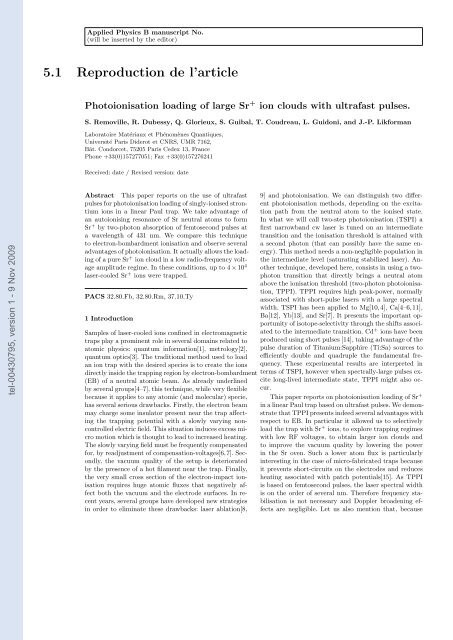

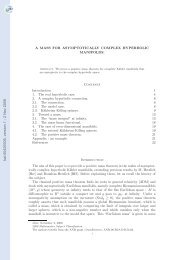
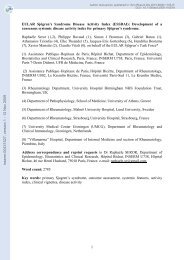
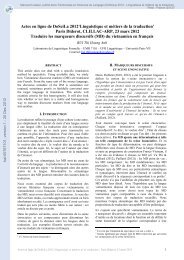
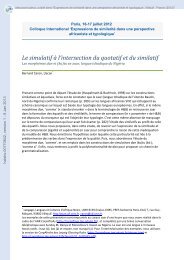
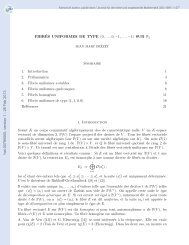
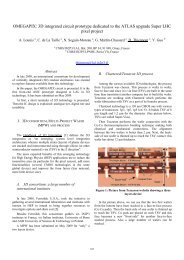
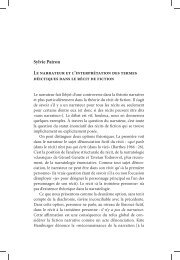
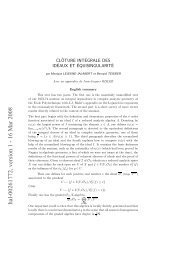
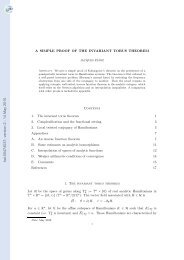

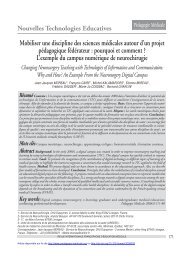

![[tel-00433556, v1] Relation entre Stress Oxydant et Homéostasie ...](https://img.yumpu.com/19233319/1/184x260/tel-00433556-v1-relation-entre-stress-oxydant-et-homeostasie-.jpg?quality=85)